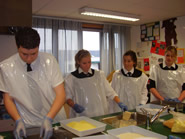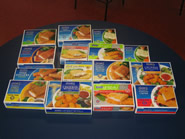The Garin College/Sealord Link

Students crumbing fish
In 2004, Nelson secondary school Technology teacher Jo Calt at Garin College went to seafood company Sealord with a request: Could one of the company's food technologists come and help her out with her senior classes?
Through the company's Human Resources manager she was put in touch with senior food technologist Frits Hofman.
Jo says when she got in touch with Sealord she didn't have any firm ideas about what she wanted. Involving a professional technologist would doubtless improve her knowledge of food science and technology, give her an overview of industrial Food Technology, and hopefully bring her lessons to life, but she had no concrete expectations or plans for Frits.
"When Frits came to the school I explained the Technology Curriculum to him and we talked about what he could do, about what directions we could take." Frits agreed to come and speak to the senior students about his job and the process of product development.
During his talk, Frits explained the steps his company followed when developing something new for the market. He described the legal and legislative aspects of product development and all the other things that don't immediately spring to mind but which have to be considered and resolved. He covered key questions in areas such as manufacturing – can the product-as-designed actually be made? Is there a cheaper way of doing that? – and marketing – What is the target market? Does the market actually exist?.
Frits was comfortable in the classroom – he'd had done some teaching in the past and had been involved in other Sealord educational/vocational initiatives. The following year, he agreed – on behalf of Sealord – to act as a client for the Year 13 project work and be involved in some of the teaching.

Sealord product range
Jo wanted the class to focus on product development. Frits suggested the best way to go about this was to have the students work through the process as a project. "How do you develop a product from scratch? What are the staging gates? What is the terminology of the process?,” are questions Frits suggested were covered. "I said the easiest way to learn all this would be for the students to take on a project. We [Sealord] had plenty of development projects, some of them we were working on and some were almost solved, but that didn't matter."
Frits presented the class with the following choice of projects:
-
Sealord are looking to develop their Greenshell mussel line, possibly by developing an additional sauce to accompany the Vac Pack in Garlic Sauce
-
Sealord wish to develop a product for the retail market using the by-product 'fish dust'
-
Sealord are looking for a retail product to complement Sealord Fish Flips and Sealord Battered and Crumbed Nuggets to expand their children's range.
-
Sealord are looking to develop a frozen meal containing seafood to add to their existing range.
-
Sealord are looking to develop a 1kg unit of frozen seafood product mix for the BBQ to break into the summer BBQ market.
-
Sealord are looking to develop an upmarket fish and sauce product for the microwave, complementing or even replacing the current Sealord Cook-in-the-bag Hoki Fillets in a Parsley Sauce.
One student elected to pursue her own project and developed a paua product, the subject of an article in the autumn 2007 edition of Te Mana Taiohi.
Sealord very generously provided a range of raw materials-including mussels, breadcrumbs and fish dust (dust and chips of frozen fish produced when blocks of fish sawn are up during processing) for the class to use.
On his visits to the classroom, Frits gave students technical advice, answered their questions, and put their work in context by relating what they were doing to what occurs in industry.

Final product
Although he did make a few front-of-class presentations on subjects such as cost accounting, Frits describes his role in the classroom as "assisting" Jo and giving the unit its practical content. "It's not a lecturing approach. It's more guiding. I get the students to ask questions and do the talking."
One thing was quickly established at the outset: Frits wasn't there to waste his time. Jo explained to the students that Frits was taking time out from a busy schedule to help them out and they responded well, she says.
In fact, their good attitude was reflected in their whole learning approach (and the results they achieved), she says. "The students sat up and paid attention. They felt accountable to the Sealord Group and not just their teacher. It wasn't just another school assignment, there was the expectation that the very best job possible was called for." The knowledge that at the end of the unit, they would have to make a presentation to Frits and some other Sealord figures, about their projects, also acted as a spur.
